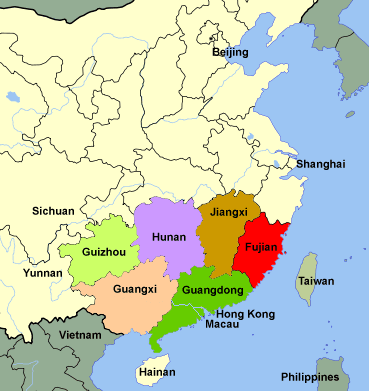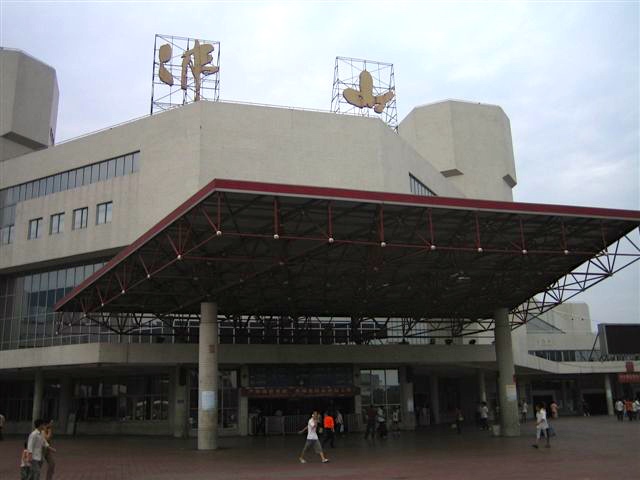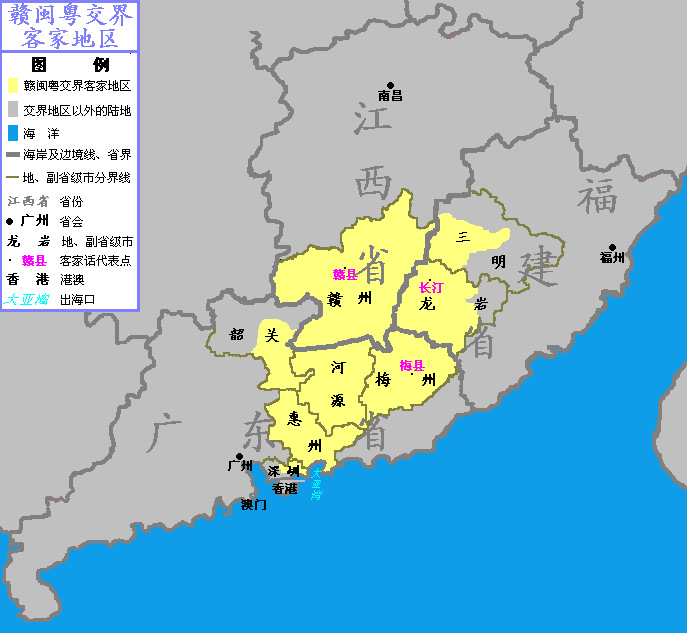|
Red Turban Rebellion (1854–1856)
The Red Turban Rebellion of 1854–1856 was a rebellion by members of the Tiandihui ( zh, c=天地會, Heaven and Earth Society) in the Guangdong province of South China. The initial core of the rebels were Tiandihui secret societies that were involved in both revolutionary activity and organised crime, such as prostitution, piracy, and opium smuggling. Many lodges were formed originally for self-defence in feuds between locals and migrants from neighboring provinces. They were organized into scattered local lodges, each under a lodge-master (堂主) and in October 1854 elected Li Wenmao and Chen Kai as joint alliance-masters (盟主). In Summer 1854, 50,000 outlaws, proclaiming a restoration of the Ming dynasty, captured Qingyuan. That roused the Tiandihui to revolt in the city of Conghua, forty miles northeast of the provincial capital. The Red Turbans were formed by religious members from Tiandihui, such as Qiu Ersao, who joined the Taiping Heavenly Kingdom with thousand ... [...More Info...] [...Related Items...] OR: [Wikipedia] [Google] [Baidu] |
Guangdong
Guangdong (, ), alternatively romanized as Canton or Kwangtung, is a coastal province in South China on the north shore of the South China Sea. The capital of the province is Guangzhou. With a population of 126.01 million (as of 2020) across a total area of about , Guangdong is the most populous province of China and the 15th-largest by area as well as the second-most populous country subdivision in the world (after Uttar Pradesh in India). Its economy is larger than that of any other province in the nation and the fifth largest sub-national economy in the world with a GDP (nominal) of 1.95 trillion USD (12.4 trillion CNY) in 2021. The Pearl River Delta Economic Zone, a Chinese megalopolis, is a core for high technology, manufacturing and foreign trade. Located in this zone are two of the four top Chinese cities and the top two Chinese prefecture-level cities by GDP; Guangzhou, the capital of the province, and Shenzhen, the first special economic zone in the count ... [...More Info...] [...Related Items...] OR: [Wikipedia] [Google] [Baidu] |
Irregular Military
Irregular military is any non-standard military component that is distinct from a country's national armed forces. Being defined by exclusion, there is significant variance in what comes under the term. It can refer to the type of military organization, or to the type of tactics used. An irregular military organization is one which is not part of the regular army organization. Without standard military unit organization, various more general names are often used; such organizations may be called a ''troop'', ''group'', ''unit'', ''column'', ''band'', or ''force''. Irregulars are soldiers or warriors that are members of these organizations, or are members of special military units that employ irregular military tactics. This also applies to irregular infantry and irregular cavalry units. Irregular warfare is warfare employing the tactics commonly used by irregular military organizations. This involves avoiding large-scale combat, and focusing on small, stealthy, hit-and-run ... [...More Info...] [...Related Items...] OR: [Wikipedia] [Google] [Baidu] |
Guangxi Province
Guangxi (; ; alternately romanized as Kwanghsi; ; za, Gvangjsih, italics=yes), officially the Guangxi Zhuang Autonomous Region (GZAR), is an autonomous region of the People's Republic of China, located in South China and bordering Vietnam (Hà Giang, Cao Bằng, Lạng Sơn, and Quảng Ninh Provinces) and the Gulf of Tonkin. Formerly a province, Guangxi became an autonomous region in 1958. Its current capital is Nanning. Guangxi's location, in mountainous terrain in the far south of China, has placed it on the frontier of Chinese civilization throughout much of Chinese history. The current name "Guang" means "expanse" and has been associated with the region since the creation of Guang Prefecture in 226 AD. It was given provincial level status during the Yuan dynasty, but even into the 20th century, it was considered an open, wild territory. The abbreviation of the region is "" (Hanyu pinyin: ; Zhuang: ), which comes from the name of the city of Guilin, the provincial capi ... [...More Info...] [...Related Items...] OR: [Wikipedia] [Google] [Baidu] |
Royal Navy
The Royal Navy (RN) is the United Kingdom's naval warfare force. Although warships were used by English and Scottish kings from the early medieval period, the first major maritime engagements were fought in the Hundred Years' War against France. The modern Royal Navy traces its origins to the early 16th century; the oldest of the UK's armed services, it is consequently known as the Senior Service. From the middle decades of the 17th century, and through the 18th century, the Royal Navy vied with the Dutch Navy and later with the French Navy for maritime supremacy. From the mid 18th century, it was the world's most powerful navy until the Second World War. The Royal Navy played a key part in establishing and defending the British Empire, and four Imperial fortress colonies and a string of imperial bases and coaling stations secured the Royal Navy's ability to assert naval superiority globally. Owing to this historical prominence, it is common, even among non-Britons, to ref ... [...More Info...] [...Related Items...] OR: [Wikipedia] [Google] [Baidu] |
Guangzhou
Guangzhou (, ; ; or ; ), also known as Canton () and alternatively romanized as Kwongchow or Kwangchow, is the capital and largest city of Guangdong province in southern China. Located on the Pearl River about north-northwest of Hong Kong and north of Macau, Guangzhou has a history of over 2,200 years and was a major terminus of the maritime Silk Road; it continues to serve as a major port and transportation hub as well as being one of China's three largest cities. For a long time, the only Chinese port accessible to most foreign traders, Guangzhou was captured by the British during the First Opium War. No longer enjoying a monopoly after the war, it lost trade to other ports such as Hong Kong and Shanghai, but continued to serve as a major transshipment port. Due to a high urban population and large volumes of port traffic, Guangzhou is classified as a Large-Port Megacity, the largest type of port-city in the world. Due to worldwide travel restrictions at the beginni ... [...More Info...] [...Related Items...] OR: [Wikipedia] [Google] [Baidu] |
Foshan
Foshan (, ), alternately romanized as Fatshan, is a prefecture-level city in central Guangdong Province, China. The entire prefecture covers and had a population of 9,498,863 as of the 2020 census. The city is part of the western side of the Pearl River Delta Economic Zone whose built-up (or metro) area was home to 65,694,622 inhabitants as of 2020 (excluding Hong Kong not conurbated yet), making it the biggest urban area of the world. Foshan is regarded as the home of Cantonese opera, a genre of Chinese opera; Nanquan, a martial art; and lion dancing. Name ''Fóshān'' is the pinyin romanization of the city's Chinese name , based on its Mandarin pronunciation. The Postal Map spelling "Fatshan" derives from the same name's local Cantonese pronunciation. Other romanizations include Fat-shan and Fat-shun. Foshan means "BuddhaMountain" and, despite the more famous present-day statue of Guanyin (or Kwanyin) on Mount Xiqiao, who isn't a Buddha, it refers to a smaller hill n ... [...More Info...] [...Related Items...] OR: [Wikipedia] [Google] [Baidu] |
Dongguan
Dongguan (; ) is a prefecture-level city in central Guangdong Province, China. An important industrial city in the Pearl River Delta, Dongguan borders the provincial capital of Guangzhou to the north, Huizhou to the northeast, Shenzhen to the south, and the Pearl River to the west. It is part of the Pearl River Delta built-up (or metro) area with more than 65.57 million inhabitants as of the 2020 census spread over nine municipalities across an area of . Dongguan's city administration is considered especially progressive in seeking foreign direct investment. Dongguan ranks behind only Shenzhen, Shanghai and Suzhou in exports among Chinese cities, with $65.54 billion in shipments. It is also home to one of the world's largest shopping malls, the New South China Mall,Utopia, Part 3: The World’s Largest Shopping Mall ... [...More Info...] [...Related Items...] OR: [Wikipedia] [Google] [Baidu] |
Huizhou
Huizhou ( zh, c= ) is a city in central-east Guangdong Province, China, forty-three miles north of Hong Kong. Huizhou borders the provincial capital of Guangzhou to the west, Shenzhen and Dongguan to the southwest, Shaoguan to the north, Heyuan to the northeast, Shanwei to the east, and Daya Bay of the South China Sea to the south. As of the 2020 census, the city has about 6,042,852 inhabitants and is administered as a prefecture-level city. Huizhou's core metropolitan area, which is within Huicheng and Huiyang Districts, is home to around 2,090,578 inhabitants. History During the Song dynasty, Huizhou was a prefectural capital of the Huiyang prefecture and the cultural center of the region. The West Lake in Huizhou was formerly known as Feng Lake. At the age of 59, Su Shi was exiled to Huizhou by the imperial government of Song. When he visited Feng Lake in Huizhou, he found it located in the west of the city and was as beautiful as West Lake in Hangzhou. Therefore, he renam ... [...More Info...] [...Related Items...] OR: [Wikipedia] [Google] [Baidu] |
Fujian
Fujian (; alternately romanized as Fukien or Hokkien) is a province on the southeastern coast of China. Fujian is bordered by Zhejiang to the north, Jiangxi to the west, Guangdong to the south, and the Taiwan Strait to the east. Its capital is Fuzhou, while its largest city by population is Quanzhou, both located near the coast of the Taiwan Strait in the east of the province. While its population is predominantly of Chinese ethnicity, it is one of the most culturally and linguistically diverse provinces in China. The dialects of the language group Min Chinese were most commonly spoken within the province, including the Fuzhou dialect of northeastern Fujian and various Hokkien dialects of southeastern Fujian. Hakka Chinese is also spoken, by the Hakka people in Fujian. Min dialects, Hakka and Mandarin Chinese are mutually unintelligible. Due to emigration, a sizable amount of the ethnic Chinese populations of Taiwan, Singapore, Malaysia, Indonesia, and the Philippines ... [...More Info...] [...Related Items...] OR: [Wikipedia] [Google] [Baidu] |
Small Swords Society
Small Swords Society or Small Knife Society was a political and military organisation active in Shanghai, China, and neighbouring areas amid the Taiping Rebellion, between about 1840 and 1855. Members of the society, rebelling against the Qing dynasty, occupied old Shanghai and many of the surrounding villages. Chinese gentry and merchants took refuge in the British and French concessions, which were regarded as the only safe places. The rebellion was suppressed and the society expelled from Shanghai in February 1855. History The organization was founded in 1850 during the upheavals leading to the Taiping Rebellion, its original leader being a Singaporean-born merchant with British citizenship, Chen Qingzhen (), in Xiamen, Fujian Province, many among its leadership also being English-speaking Singapore Chinese. It was one of a number of rebel groups to arise during this period, either affiliated with or proclaiming support for the Taiping administration. The name ("Small Swords" ... [...More Info...] [...Related Items...] OR: [Wikipedia] [Google] [Baidu] |






.jpg)

